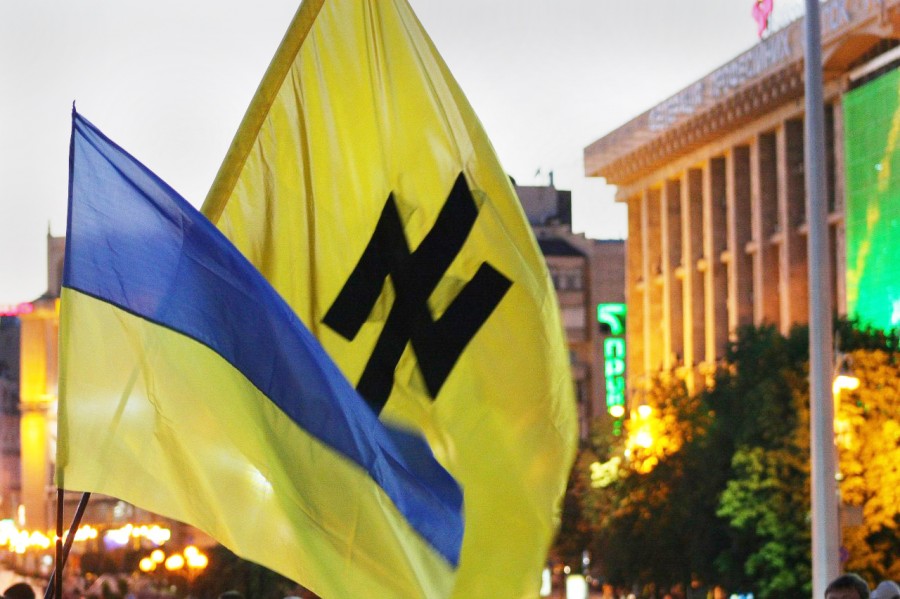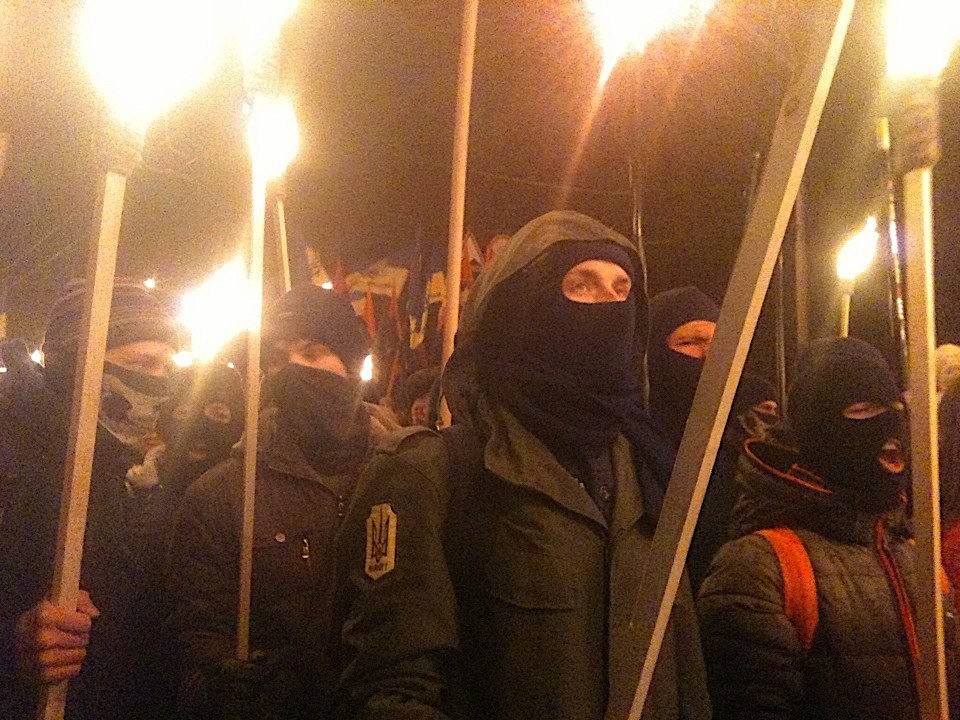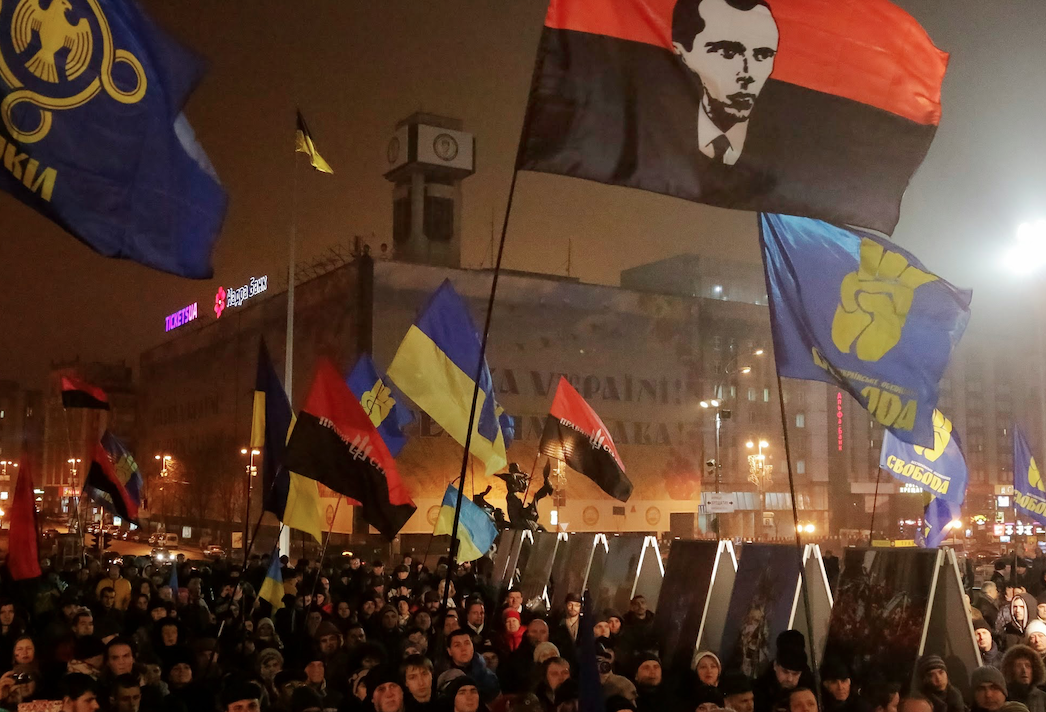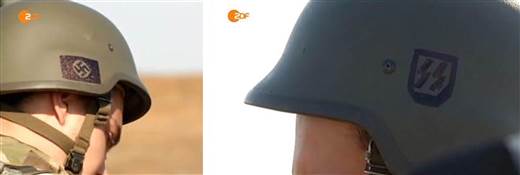"When US House Saw Ukraine’s Neo-Nazis"
by Robert Parry
Consortium News (March 6, 2022)
https://consortiumnews.com/2022/03/06/robert-parry-when-us-house-saw-ukraines-neo-nazis/
The U.S. government and media think Nazis in Ukraine are a myth. It wasn’t always the case, as Robert Parry reported in 2015.
US House Admits Nazi Role in Ukraine
Exclusive: The U.S. House of Representatives has admitted an ugly truth that the U.S. mainstream media has tried to hide from the American people: that the post-coup regime in Ukraine has relied heavily on Nazi storm troopers to carry out its bloody war against ethnic Russians, reports Robert Parry.

The neo-Nazi Wolfsangel symbol on a banner in Ukraine.
By Robert Parry
Special to Consortium News
June 12, 2015
Last February, when ethnic Russian rebels were closing in on the Ukrainian port of Mariupol, The New York Times rhapsodically described the heroes defending the city and indeed Western civilization the courageous Azov battalion facing down barbarians at the gate. What the Times didn’t tell its readers was that these “heroes” were Nazis, some of them even wearing Swastikas and SS symbols.
The long Times article by Rick Lyman fit with the sorry performance of America’s “paper of record” as it has descended into outright propaganda hiding the dark side of the post-coup regime in Kiev. But what makes Lyman’s sadly typical story noteworthy today is that the Republican-controlled U.S. House of Representatives has just voted unanimously to bar U.S. assistance going to the Azov Battalion because of its Nazi ties.
When even the hawkish House of Representatives can’t stomach these Nazi storm troopers who have served as Kiev’s tip of the spear against the ethnic Russian population of eastern Ukraine, what does that say about the honesty and integrity of The New York Times when it finds these same Nazis so admirable?
And it wasn’t like the Times didn’t have space to mention the Nazi taint. The article provided much color and detail quoting an Azov leader prominently but just couldn’t find room to mention the inconvenient truth about how these Nazis had played a key role in the ongoing civil war on the U.S. side. The Times simply referred to Azov as a “volunteer unit.”
Yet, on June 10, the U.S. House of Representatives approved a bipartisan amendment to the Defense Appropriations Act from Reps. John Conyers Jr., D-Michigan, and Ted Yoho, R-Florida that would block U.S. training of the Azov battalion and would prevent transfer of shoulder-fired anti-aircraft missiles to fighters in Iraq and Ukraine.
“I am grateful that the House of Representatives unanimously passed my amendments last night to ensure that our military does not train members of the repulsive neo-Nazi Azov Battalion, along with my measures to keep the dangerous and easily trafficked MANPADs out of these unstable regions,” said Conyers on Thursday.
He described Ukraine’s Azov Battalion as a 1,000-man volunteer militia of the Ukrainian National Guard that Foreign Policy magazine has characterized as “openly neo-Nazi” and “fascist.” And Azov is not some obscure force. Ukraine’s Interior Minister Arsen Avakov, who oversees Ukraine’s armed militias, announced that Azov troops would be among the first units to be trained by the 300 U.S. military advisers who have been dispatched to Ukraine in a training mission codenamed “Fearless Guardian.”
[Later, under pressure from the Pentagon in December 2015 the amendment barring funding to Azov was removed from the 2016 House Defense Appropriations Act (HR 2685).]
White Supremacy

Torchlight parade of neo-Nazis in Ukraine, Jan. 2015. (Frest777/Wikimedia Commons)
On Friday, a Bloomberg News article by Leonid Bershidsky noted that “it’s easy to see why” Conyers “would have a problem with the military unit commanded by Ukrainian legislator Andriy Biletsky: Conyers is a founding member of the Congressional Black Caucus, Biletsky is a white supremacist.
Biletsky had run Patriot of Ukraine [the precursor of the Azov battalion] since 2005. In a 2010 interview he described the organization as nationalist ‘storm troops’ … The group’s ideology was ‘social nationalism’ — a term Biletsky, a historian, knew would deceive no one.
In 2007, Biletsky railed against a government decision to introduce fines for racist remarks: ‘So why the “Negro-love” on a legislative level? They want to break everyone who has risen to defend themselves, their family, their right to be masters of their own land! They want to destroy the Nation’s biological resistance to everything alien and do to us what happened to Old Europe, where the immigrant hordes are a nightmare for the French, Germans and Belgians, where cities are “blackening” fast and crime and the drug trade are invading even the remotest corners.’”
The Bloomberg article continued
“Biletsky landed in prison in 2011, after his organization took part in a series of shootouts and fights. Following Ukraine’s so-called revolution of dignity last year, he was freed as a political prisoner; right-wing organizations, with their paramilitary training, played an important part in the violent phase of the uprising against former President Viktor Yanukovych. The new authorities — which included the ultra-nationalist party Svoboda — wanted to show their gratitude.
The war in the east gave Biletsky’s storm troopers a chance at a higher status than they could ever have hoped to achieve. They fought fiercely, and last fall, the 400-strong Azov Battalion became part of the National Guard, receiving permission to expand to 2,000 fighters and gaining access to heavy weaponry. So what if some of its members had Nazi symbols tattooed on their bodies and the unit’s banner bore the Wolfsangel, used widely by the Nazis during World War II?
In an interview with Ukraine’s Focus magazine last September, Avakov, responsible for the National Guard, was protective of his heroes. He said of the Wolfsangel: ‘In many European cities it is part of the city emblem. Yes, most of the guys who assembled in Azov have a particular worldview. But who told you you could judge them? Don’t forget what the Azov Battalion did for the country. Remember the liberation of Mariupol, the fighting at Ilovaysk, the latest attacks near the Sea of Azov. May God allow anyone who criticizes them to do 10 percent of what they’ve done. And anyone who’s going to tell me that these guys preach Nazi views, wear the swastika and so on, are bare-faced liars and fools.’”
Though the House vote on June 10 may have shined a spotlight into this dark corner of the U.S.-embraced Kiev regime, the reality has been well-known for many months though played down in most of the Western news media, often dismissed as “Russian propaganda.”
Even the Times has included at least one brief reference to this reality, though buried deep inside an article. On Aug. 10, 2014, a Times’ article mentioned the Nazi taint of the Azov battalion in the last three paragraphs of a lengthy story on another topic.
“The fighting for Donetsk has taken on a lethal pattern: The regular army bombards separatist positions from afar, followed by chaotic, violent assaults by some of the half-dozen or so paramilitary groups surrounding Donetsk who are willing to plunge into urban combat,” the Times reported.
“Officials in Kiev say the militias and the army coordinate their actions, but the militias, which count about 7,000 fighters, are angry and, at times, uncontrollable. One known as Azov, which took over the village of Marinka, flies a neo-Nazi symbol resembling a Swastika as its flag.” [See Consortiumnews.com’s “NYT Discovers Ukraine’s Neo-Nazis at War.”]
A Shiver Down the Spine

Torchlight procession in honor of the 106 anniversary of the birthday of Stepan Bandera, Kiev, Jan. 1, 2015. (All-Ukrainian Union CC BY 3.0, Wikimedia Commons)
The conservative London Daily Telegraph offered more details about the Azov battalion in an article by correspondent Tom Parfitt, who wrote:
“Kiev’s use of volunteer paramilitaries to stamp out the Russian-backed Donetsk and Luhansk ‘people’s republics’ should send a shiver down Europe’s spine.
Recently formed battalions such as Donbas, Dnipro and Azov, with several thousand men under their command, are officially under the control of the interior ministry but their financing is murky, their training inadequate and their ideology often alarming. The Azov men use the neo-Nazi Wolfsangel (Wolf’s Hook) symbol on their banner and members of the battalion are openly white supremacists, or anti-Semites.”
Based on interviews with militia members, the Telegraph reported that some of the fighters doubted the reality of the Holocaust, expressed admiration for Adolf Hitler and acknowledged that they are indeed Nazis [emphasis added].
Biletsky, the Azov commander, “is also head of an extremist Ukrainian group called the Social National Assembly,” according to the Telegraph article which quoted a commentary by Biletsky as declaring: “The historic mission of our nation in this critical moment is to lead the White Races of the world in a final crusade for their survival. A crusade against the Semite-led Untermenschen.”
In other words, for the first time since World War II, a government had dispatched Nazi storm troopers to attack a European population and officials in Kiev knew what they were doing. The Telegraph questioned Ukrainian authorities in Kiev who acknowledged that they were aware of the extremist ideologies of some militias but insisted that the higher priority was having troops who were strongly motivated to fight. [See Consortiumnews.com’s “Ignoring Ukraine’s Neo-Nazi Storm Troopers.”]
But a rebel counteroffensive led by ethnic Russians last August reversed many of Kiev’s gains and drove the Azov and other government forces back to the port city of Mariupol, where Foreign Policy’s reporter Alec Luhn also encountered the Nazis. He wrote:
“Blue and yellow Ukrainian flags fly over Mariupol’s burned-out city administration building and at military checkpoints around the city, but at a sport school near a huge metallurgical plant, another symbol is just as prominent: the wolfsangel (‘wolf trap’) symbol that was widely used in the Third Reich and has been adopted by neo-Nazi groups.
Pro-Russian forces have said they are fighting against Ukrainian nationalists and ‘fascists’ in the conflict, and in the case of Azov and other battalions, these claims are essentially true.”
SS Helmets

Nazi symbols on helmets worn by members of Ukraine’s Azov battalion. (As filmed by a Norwegian film crew and shown on German TV)
More evidence continued to emerge about the presence of Nazis in the ranks of Ukrainian government fighters. Germans were shocked to see video of Azov militia soldiers decorating their gear with the Swastika and the “SS rune.” NBC News reported:
“Germans were confronted with images of their country’s dark past when German public broadcaster ZDF showed video of Ukrainian soldiers with Nazi symbols on their helmets in its evening newscast.
The video was shot in Ukraine by a camera team from Norwegian broadcaster TV2. ‘We were filming a report about Ukraine’s AZOV battalion in the eastern city of Urzuf, when we came across these soldiers,’ Oysten Bogen, a correspondent for the private television station, told NBC News. Minutes before the images were taped, Bogen said he had asked a spokesperson whether the battalion had fascist tendencies. ‘The reply was: absolutely not, we are just Ukrainian nationalists,’ Bogen said.”
Despite the newsworthiness of a U.S.-backed government dispatching Nazi storm troopers to attack Ukrainian cities, the major U.S. news outlets have gone to extraordinary lengths to excuse this behavior, with The Washington Post publishing a rationalization that Azov’s use of the Swastika was merely “romantic.”
“In other words, for the first time since World War II, a government had dispatched Nazi storm troopers to attack a European population and officials in Kiev knew what they were doing.”
This curious description of the symbol most associated with the depravity of the Holocaust and the devastation of World War II can be found in the last three paragraphs of a Post lead story published in September 2014. Post correspondent Anthony Faiola portrayed the Azov fighters as “battle-scarred patriots” nobly resisting “Russian aggression” and willing to resort to “guerrilla war” if necessary.
The article found nothing objectionable about Azov’s plans for “sabotage, targeted assassinations and other insurgent tactics” against Russians, although such actions in other contexts are regarded as terrorism. The extremists even extended their threats to the government of Ukrainian President Petro Poroshenko if he agrees to a peace deal with the ethnic Russian east that is not to the militia’s liking.
“If Kiev reaches a deal with rebels that they don’t support, paramilitary fighters say they could potentially strike pro-Russian targets on their own, or even turn on the government itself,” the article stated.
The Post article like almost all of its coverage of Ukraine was laudatory about the Kiev forces fighting ethnic Russians in the east, but the newspaper did have to do some quick thinking to explain a photograph of a Swastika gracing an Azov brigade barracks. So, in the last three paragraphs of the story, Faiola reported: “One platoon leader, who called himself Kirt, conceded that the group’s far right views had attracted about two dozen foreign fighters from around Europe.
“In one room, a recruit had emblazoned a swastika above his bed. But Kirt dismissed questions of ideology, saying that the volunteers, many of them still teenagers, embrace symbols and espouse extremist notions as part of some kind of ‘romantic’ idea.”
Despite these well-documented facts, The New York Times excised this reality from its article about the Azov Battalion’s defense of Mariupol last February. But isn’t the role of Nazis newsworthy? In other contexts, the Times is quick to note and condemn any sign of a Nazi resurgence in Europe. However, in Ukraine, where neo-Nazis, such as Andriy Parubiy served as the coup regime’s first national security chief and Nazi militias are at the center of regime’s military operations, the Times goes silent on the subject.
Rather than fully inform its readers about a crisis that has the potential of becoming a nuclear showdown between the United States and Russia, the Times has chosen to simply be a fount of State Department propaganda, often terming any reference to Kiev’s Nazi storm troopers to be “Russian propaganda.” Now, however, a unanimous U.S. House of Representatives — of all things — has acknowledged the unpleasant truth.
The late investigative reporter Robert Parry broke many of the Iran-Contra stories for The Associated Press and Newsweek in the 1980s. He founded Consortium News in 1995.